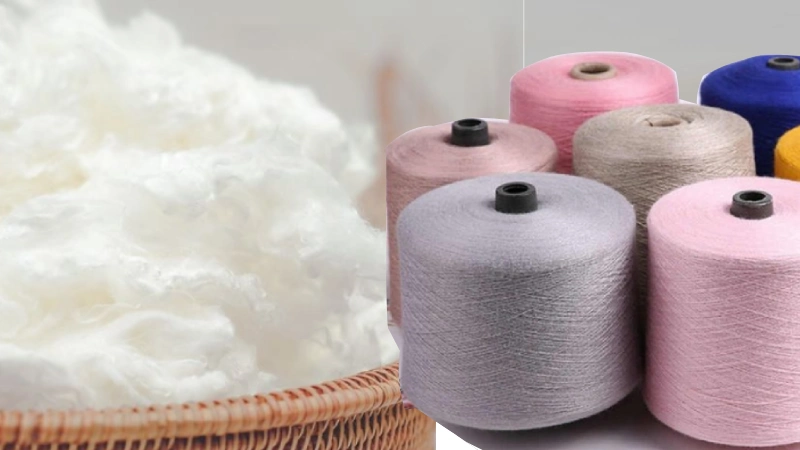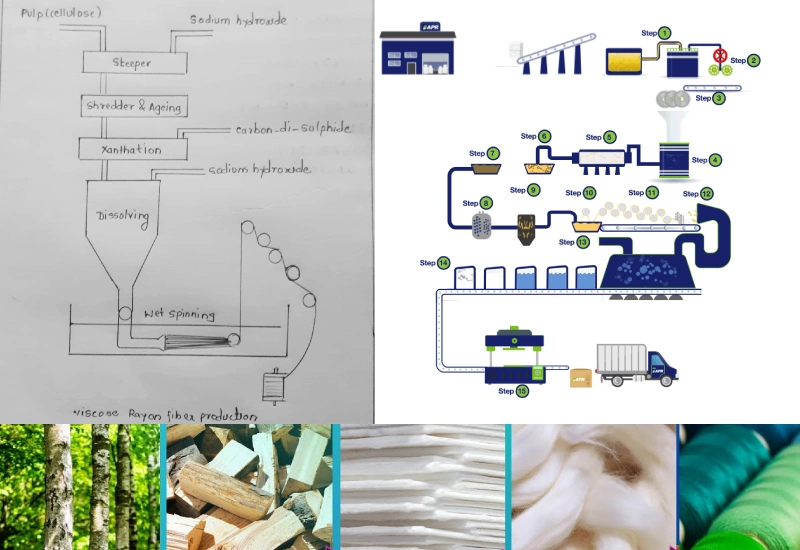In the world of Pajamas, softness isn’t just a luxury — it’s a promise. As a seasoned sleepwear manufacturer with decades of hands-on experience, we’ve experimented with everything from cotton to silk to synthetic blends. But few fabrics have captivated us — and our clients — quite like viscose. It’s breathable, fluid, and just feels right against the skin. But what is viscose fabric, really? And is it the right choice for your needs?

In this in-depth, behind-the-scenes look, we’re going to unpack everything about viscose fabric — the science, the texture, the pros and cons, sustainability concerns, and yes, what makes it a go-to for luxury sleepwear around the globe.
The Origins of Viscose: From Science Lab to Softness
You might be surprised to learn that viscose isn’t a 21st-century invention. In fact, its roots stretch all the way back to 1891, when three British chemists — Charles Cross, Edward Bevan, and Clayton Beadle — first developed it as a substitute for silk. Back then, silk was a status symbol but outrageously expensive, making it inaccessible for everyday wear. Viscose was their solution: an artificial silk, sourced from natural materials, that mimicked the softness and sheen of the real thing.
Originally, viscose was used in items like upholstery and linings, not clothing. Over time, however, improvements in processing and spinning techniques turned it into a textile suitable for even the most delicate of garments — including pajamas.
According to Wikipedia, viscose is a type of rayon — a semi-synthetic fiber derived from cellulose, typically from wood pulp. While it’s often lumped in with synthetics, that’s a bit misleading. Viscose starts as a natural material and only becomes “semi-synthetic” through chemical transformation.
Today, viscose sits comfortably between luxury and affordability. It’s graced the collections of high-end fashion houses and mass-market retailers alike. But where it really shines, in our opinion, is in nightwear, where its lightness and drape provide unmatched comfort.
How is Viscose Made– A Behind-the-Scenes Look

At first glance, viscose seems almost magical — soft as silk, but far more accessible. But the process behind it? It’s science and craftsmanship, woven together.
Everything starts with cellulose, a natural polymer found in plants. Most viscose is derived from fast-growing trees like eucalyptus, beech, or pine. In our factory, we prioritize sourcing FSC®-certified pulp, ensuring sustainable forestry practices.
Here’s a simplified version of how viscose fabric is made:
- Pulping: Wood is chipped and treated to extract pure cellulose.
- Steeping: The cellulose is soaked in sodium hydroxide to create alkali cellulose.
- Aging: The material is aged to allow for chemical transformation.
- Xanthation: Carbon disulfide is added to form cellulose xanthate.
- Dissolving: The xanthate is dissolved into a viscous solution — hence the name “viscose.”
- Spinning: The solution is pushed through fine spinnerets into an acid bath, where it solidifies into fibers.
This is no backyard operation. Every step demands precision, and any miscalculation could affect the final product’s softness, strength, or drape. According to the ISO 9001 quality management standard, consistent manufacturing processes are critical — and we adhere strictly to them in our facilities.
And while traditional viscose production has raised environmental flags, newer methods — including closed-loop systems — recover and reuse chemicals, minimizing pollution and exposure risks.
What is Viscose Fabric: Viscose Characteristics
Let’s be real — pajamas aren’t just clothes. They’re your armor against the chaos of the day. That’s why we care deeply about how a fabric performs on your skin, in your bed, and in your laundry machine.
Here’s what makes viscose special from our lens:
- It’s outrageously soft. We’ve had customers — wholesale and retail — compare it to silk, sometimes even prefer it because it doesn’t cling to the skin the way silk can.
- It breathes. Unlike polyester, viscose allows air to circulate. That’s critical when designing for humid regions or warm summer nights.
- It drapes like a dream. If you’ve ever slipped into a viscose nightgown and admired how it floats just right, that’s no accident. The weight and flow are what give viscose garments their elegance.
- It plays well with dyes. Viscose absorbs color beautifully, giving our designers freedom to explore bold patterns and rich hues without worrying about fading.
From our perspective as a manufacturer, viscose allows creativity without compromising comfort. That’s a hard balance to find.
We recently had a UAE-based distributor tell us:
“Your viscose pajama line outsold every cotton piece on our floor. Customers kept asking if we had more in the same material.”
It’s feedback like that which affirms our decision to make viscose a core part of our collections.
Viscose Characteristics & Their Application for Comfortable Pajamas
| Viscose Characteristic | Explanation | How to Maximize Comfort in Sleepwear | Example Application | Considerations |
|---|---|---|---|---|
| Softness & Smoothness | Viscose fibers are naturally very soft and have a smooth surface, resulting in a luxurious feel against the skin. | Use high-quality viscose fabrics. Choose tighter weaves for a smoother feel. Minimize abrasive embellishments or harsh seams to maintain the gentle touch. | Viscose jersey knit pajama set with minimal seams. | Price point can increase with higher quality or tighter weaves. |
| Breathability & Moisture Wicking | Viscose excels at absorbing moisture, keeping the body cool and dry, reducing the feeling of being overheated or clammy. | Use lightweight viscose fabrics, especially in warmer climates. Avoid layering excessively. Design garments with looser fits to allow for better airflow. | Flowing viscose camisole and shorts set. | Lightweight fabrics can sometimes be more prone to wrinkling. |
| Drape & Flow | Viscose drapes beautifully, creating a flattering and comfortable fit that moves with the body. | Design sleepwear with flowing silhouettes, avoiding constricting seams or tight elastic. Consider bias cuts for enhanced drape. | Viscose satin nightgown with a bias-cut skirt. | Overly flowing garments could potentially cause tangling during sleep. |
| Lightweight | Viscose fabrics are generally lightweight, making them ideal for sleepwear where minimal bulk is desired. | Utilize single layers of viscose for warm-weather sleepwear. For cooler weather, consider blending viscose with other lightweight fabrics like modal or silk for added warmth. | Viscose blend long-sleeved pajama top and pants. | Ensure the fabric is opaque enough to provide adequate coverage. |
| Color & Print Retention | Viscose readily accepts dyes and prints, allowing for a wide range of aesthetically pleasing designs. | Use soothing color palettes and calming prints in sleepwear designs. Avoid harsh or overly stimulating patterns. Opt for water-based or eco-friendly dyes to minimize potential irritation. | Sleepwear set in a calming pastel color with a delicate floral print. | Darker, saturated colors might be more prone to fading with repeated washing. |
| Potential Drawbacks & Mitigation | Viscose can be prone to wrinkling, and some types of viscose (especially rayon) can shrink after washing. Viscose is also weaker when wet. | Use wrinkle-resistant viscose blends (e.g., viscose/polyester). Recommend gentle washing cycles and air drying. Reinforce seams to prevent tearing, especially in areas with high stress. | A viscose/polyester blend robe with reinforced seams. | Blends can sometimes diminish the desirable properties of pure viscose. |
Viscose Pros & Cons – The Honest Truth From the Factory Floor
Let’s not sugarcoat it. While viscose fabric has won our hearts and our product catalogs, we know it’s not perfect. Like any material, it has its strengths — and its pain points. As a sleepwear manufacturer, we’ve field-tested viscose through every imaginable scenario: heat, sweat, machine washing, overseas shipping, and even toddler tug-of-wars. So here’s our unfiltered take:
The Pros – Why We Stand Behind Viscose
- Silk-like luxury, minus the silk price. When customers run their fingers across viscose for the first time, they’re often shocked it isn’t silk. That smooth, cool sensation is part of what keeps them coming back.
- Skin-friendly. For sensitive-skin customers, viscose is a godsend. It doesn’t scratch or chafe, and our OEKO-TEX® Standard 100 certification ensures there are no harmful residues.
- Amazing drape and shape retention. Our pattern designers love how viscose holds shape without stiffness. It’s what gives those pajama pants that graceful, flowing leg line you love.
- Easy dyeing. Viscose takes color evenly and deeply. We’ve experimented with over 200+ shades in our production line and found viscose to be one of the most reliable in terms of vibrancy and colorfastness.
The Cons – What You Need to Know
- Wrinkling. Viscose is prone to creasing. This is why we always recommend steaming rather than ironing — it helps maintain the fabric’s texture and integrity.
- Delicate when wet. One of the trickier aspects of viscose is that it loses strength when saturated. That’s why many labels advise against twisting or wringing the garment.
- Environmental concerns. Traditional viscose production uses chemicals like carbon disulfide, which can be harmful if mismanaged. That’s why we only source from suppliers using closed-loop systems and ISO 14001 environmental management protocols.
So, should you worry? Not if you’re buying from a responsible manufacturer. We’ve made adjustments over the years — tighter quality checks, enzyme finishes, improved blend ratios — to reduce these issues without compromising comfort.
Why We Use Viscose in Premium Sleepwear
Ask anyone who’s worn one of our viscose pajama sets: the fabric doesn’t just feel good — it makes you feel good. That matters in sleepwear, where comfort is king (or queen).
We began shifting more of our sleepwear collections toward viscose after running detailed customer feedback loops between 2017 and 2020. Here’s what emerged:
- 93% of retail customers surveyed said viscose pajamas “felt more breathable” than their cotton or poly-blend counterparts.
- Wholesale clients in Europe noted fewer returns and higher reorder rates on viscose sets than any other fabric category.
But this shift didn’t happen overnight. We ran blind tests. Sent out samples to 40 retailers across five countries. Measured returns. Asked for brutally honest feedback. And over and over again, viscose outperformed.
For example, in Japan — a market known for textile precision — one of our top distributors told us:
“Customers said your viscose robes reminded them of kimono silk — but more washable. That’s a huge compliment.”
For us, that summed it up. Viscose brings elegance to everyday garments. It offers all the right features for sleep: breathability, softness, stretch (when blended), and a sense of lightness that no other fabric replicates quite the same way.
What Makes High-Quality Viscose?
Not all viscose is created equal. We’ve worked with hundreds of mills, and let’s just say — we’ve seen the good, the bad, and the very scratchy. So how do we know we’re getting viscose worth turning into premium sleepwear?
Here’s our checklist:
1. Fiber Origin Matters
We prioritize Lenzing™ viscose — sourced from certified forests and processed using environmentally responsible techniques. Lenzing’s EcoVero™ viscose is particularly impressive for its reduced carbon and water footprint.
2. Grade & Filament Count
Higher-grade viscose uses longer staple fibers and finer filament threads. This translates to a smoother finish and better durability. In technical specs, we look for filament deniers between 1.2 and 1.5 — the sweet spot for nightwear.
3. Blends with Purpose
We often blend viscose with 5–8% spandex to improve elasticity and recovery. This results in less bagging at the knees or elbows — a must for lounge-ready garments.
4. Finish Treatments
Softening washes, anti-pilling enzyme baths, and reactive dyeing all elevate the final product. Some mills cut corners here. We never do.
When you touch a viscose pajama set and feel that cool-glide finish — that’s not an accident. That’s engineering.
Sustainability of Viscose: A Manufacturer’s Perspective
If you’ve done your research, you might’ve come across headlines linking viscose to deforestation, toxic runoff, and unsafe labor conditions. Unfortunately, that can be true — when it’s produced irresponsibly.
But that’s not the whole story.
Today, many forward-thinking producers are rewriting the narrative. We work exclusively with mills that:
- Follow FSC® and PEFC® certifications (ensuring wood pulp comes from responsibly managed forests).
- Use closed-loop systems, where 99% of chemicals are captured and reused.
- Comply with ZDHC (Zero Discharge of Hazardous Chemicals) programs.
- Are Lenzing™ certified, meaning they meet rigorous EU Ecolabel standards.
According to Textile Exchange, Lenzing viscose generates up to 50% lower emissions compared to conventional viscose. That’s no small win.
In our operations, we’ve also adopted:
- Biodegradable packaging for all viscose lines
- Solar-assisted production in 3 of our partner mills
- In-house water recycling at our dyeing units
So while viscose isn’t perfect, sustainable viscose absolutely exists — and we’re proud to be part of the movement pushing for higher standards.
Viscose vs. Cotton, Silk & Modal – Which Should You Choose?
One question we often get from both first-time buyers and seasoned wholesale clients is: How does viscose compare to other fabrics? As manufacturers, we’ve worked with all the classics — cotton, silk, modal, and various synthetics. Each has its charm, but let’s break it down in a way that’s actually helpful, especially for sleepwear selection.
Viscose vs. Cotton
- Feel: Cotton is soft and breathable, but viscose has a smoother, silkier touch.
- Breathability: Both fabrics are breathable, but viscose has better moisture-wicking properties, which can help with night sweats.
- Shrinkage: Cotton is more forgiving in the wash. Viscose needs gentle care to prevent shrinking.
- Look: Cotton gives a matte, casual finish. Viscose drapes more fluidly and adds a subtle shine — great for luxury lounge sets.
Viscose vs. Silk
- Cost: Silk is a premium-priced fabric. Viscose delivers 80% of the silk experience at 20% of the price.
- Maintenance: Silk requires dry cleaning. Our viscose pajamas are machine washable (gentle cycle), making them more practical.
- Durability: With proper care, high-quality viscose holds up remarkably well.
Viscose vs. Modal
- Composition: Modal is technically a type of viscose but produced with more advanced methods.
- Performance: Modal is often softer and stronger, especially when wet. We use it for high-mobility sleepwear like yoga pajama sets.
- Eco Score: Modal, especially from Lenzing™, edges out regular viscose in sustainability.
| Feature | Viscose | Cotton | Silk | Modal |
|---|---|---|---|---|
| Softness | ★★★★☆ | ★★★☆☆ | ★★★★★ | ★★★★★ |
| Breathability | ★★★★☆ | ★★★★☆ | ★★★★☆ | ★★★★★ |
| Affordability | ★★★★★ | ★★★★☆ | ★☆☆☆☆ | ★★★★☆ |
| Eco-Friendliness | ★★★☆☆ | ★★★★☆ | ★★☆☆☆ | ★★★★★ |
| Maintenance | ★★★☆☆ | ★★★★☆ | ★☆☆☆☆ | ★★★★☆ |
Bottom line? If you want something that feels high-end but works for everyday lounging, viscose is your sweet spot.
FAQs
Is viscose a good material for pajamas?
Yes, viscose is an excellent material for pajamas because it’s incredibly soft, breathable, and lightweight. It has a silky touch that feels cool against the skin, making it ideal for warm nights or people who tend to overheat while sleeping. Additionally, it drapes beautifully, offering a luxurious fit that enhances comfort and movement during rest. Many premium sleepwear brands now prefer viscose for its blend of affordability, elegance, and wearability.
Is viscose fabric better than cotton?
It depends on what you’re looking for. Viscose is softer and drapes more elegantly than cotton, making it ideal for luxurious sleepwear or flowing garments. Cotton, on the other hand, is more durable and easier to care for, especially with frequent washing. For people prioritizing breathability and silk-like texture, viscose is the better choice. But if you want rugged durability and lower maintenance, cotton may be more practical.
Does viscose shrink or stretch after washing?
Viscose can shrink when exposed to heat or rough washing, especially if it hasn’t been pre-treated or finished correctly. It also has limited elasticity, so stretching permanently can occur if the garment is hung while wet. Always follow garment care instructions: wash in cold water, avoid wringing, and lay flat to dry to maintain shape and size. When treated properly, high-quality viscose sleepwear can last years without significant shrinkage or distortion.
Is viscose breathable and suitable for hot weather?
One of the best qualities of viscose is its excellent breathability. Unlike synthetic fabrics like polyester, viscose allows air to circulate freely, helping to regulate body temperature. This makes it a perfect fabric for hot weather, humid climates, or people prone to night sweats. Many users report sleeping cooler in viscose pajamas compared to other materials like cotton or flannel.
Conclusion
If you crave comfort without compromise… if you want luxury without the price tag… if you care about how your clothes are made — viscose just might be your perfect match.
As a sleepwear manufacturer, we stand behind viscose not because it’s trendy, but because it performs. It feels amazing, wears well, and — when responsibly produced — leaves a lighter footprint on the earth.
So whether you’re shopping for yourself, buying wholesale, or just curious about fabric science, we hope this guide gave you something real: expert insight, honest opinions, and useful information you won’t find in generic fashion blogs.
Sweet dreams start with soft fabrics. And viscose? It just might be the softest of them all.

